China’s infrastructure construction is developing at a rapid pace, and a series of super projects are also affecting the world.
In the past post,we talked about”Top 10 New Architectural Wonders In China“.In this post,we will talk about Top 10 Super Projects In China.
1.Hong Kong-Zhuhai-Macao Bridge(港珠澳大桥)
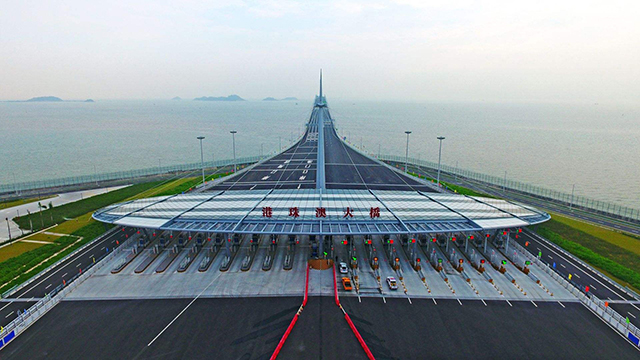
Hong Kong-Zhuhai-Macao Bridge is a bridge and tunnel project connecting Hong Kong, Zhuhai and Macao in China. It is located in the Boyang area of Guangdong Province, China, and is the southern section of the Ring Expressway in the Pearl River Delta region.
The Hong Kong-Zhuhai-Macao Bridge was started on December 15, 2009. On July 7, 2017, the main project of the Hong Kong-Zhuhai-Macao Bridge was completed. On February 6, 2018, the main body of the Hong Kong-Zhuhai-Macao Bridge was completed and accepted, on September 28 of the same year. From the beginning of the day, the joint trial operation of Guangdong, Hong Kong and Macao will be carried out.
The Hong Kong-Zhuhai-Macao Bridge starts from the Hong Kong Port artificial island near the Hong Kong International Airport. It connects the Zhuhai and Macao artificial islands westward across the Bohai Sea and ends at Zhuhai Hongwan. The total length of the bridge and tunnel is 55 kilometers, of which the main bridge is 29.6. The distance from the port of Hong Kong to the Zhuhai-Macao port is 41.6 kilometers; the bridge deck is a two-way six-lane expressway with a design speed of 100 km/h; the total investment of the project is 126.9 billion yuan.
On October 23, 2018, the opening ceremony of the Hong Kong-Zhuhai-Macao Bridge was held in Zhuhai, Guangdong. Xi Jinping attended the ceremony and announced the official opening of the bridge. The bridge was officially opened at 9:00 on October 24 of the same year. The first batch of Guangdong began on December 1 of the same year. The non-operating car in Australia and Africa can be exempted from the Hong Kong-Zhuhai-Macao Bridge.
2.Beijing-Urumqi Expressway(北京-乌鲁木齐高速公路)
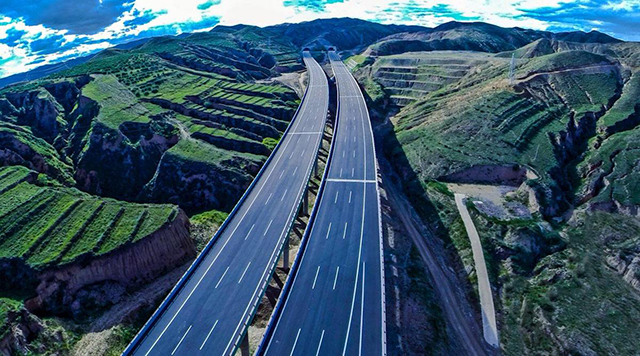
Beijing-Urumqi Expressway, referred to as Jingxin Expressway, also known as Jingxin Expressway, China National Highway Network No.: G7.
The Beijing-Xinjiang Expressway is an expressway connecting Beijing and Urumqi, as well as an important traffic artery for the development of the western region of the country. It has a total length of 2,540 kilometers and was started in September 2012. The Beijing-Xinjiang Expressway is the largest single-channel construction project in Asia and the longest desert highway in the world.
Along the line through Beijing – Zhangjiakou – Wulanchabu – Hohhot – Baotou – Bayan Muer (Linhe) – Alashan (Ejina) – Jiuquan (Ma Yushan) – Hami – Turpan – Urumqi. The starting point of Jingxin Expressway (Beijing Fifth Ring Road – Sixth Ring Road Section) was opened to traffic on May 24, 2014; the Xinghe South Toll Station to Xinjiang section of Wulanchabu City, Inner Mongolia was opened to traffic on July 15, 2017.
3.Five-hundred-meter Aperture Spherical Telescope(中国“天眼”)
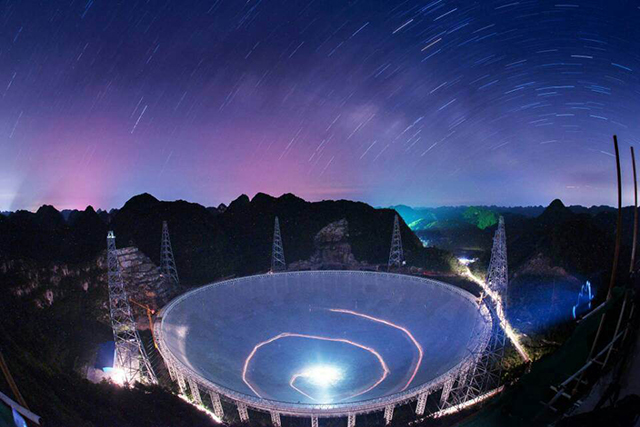
Five-hundred-meter Aperture Spherical Telescope, referred to as FAST, is located in the karst crater of Dawotun, Kedu Town, Pingtang County, Qiannan County, Guizhou Province. The project is a national major science and technology infrastructure, and the “Tianyan” project is initiated. The reflective surface system, the feed support system, the measurement and control system, the receiver and the terminal, and the observation base are composed of many parts.
The 500-meter spherical radio telescope is known as the “Chinese Eyes”. It was proposed by the Chinese astronomer Nan Rendong in 1994. It was completed in 22 years and was opened on September 25, 2016. It is built by the National Astronomical Observatory of the Chinese Academy of Sciences and has China’s independent intellectual property rights, the world’s largest single-caliber, and the most sensitive radio telescope. The overall performance is ten times that of the famous radio telescope Arecibo.
As of September 12, 2018, 59 high-quality pulsar candidates have been identified in the 500-meter spherical radio telescope, of which 44 have been identified as newly discovered pulsars.
4.China National GeneBank(中国国家基因库)
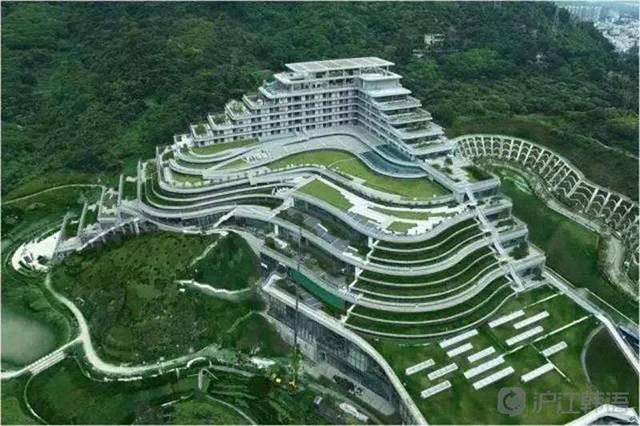
The National Gene Bank is a national-level public welfare innovation research and industrial infrastructure construction project serving the national strategy. It is the only national gene bank approved in China. In order to store, manage and utilize genetic resources, it provides a support platform for China’s biotechnology and life economic development.
In October 2011, it was approved by the National Development and Reform Commission, the Ministry of Finance, the Ministry of Industry and Information Technology, and the National Health and Family Planning Commission. The Shenzhen National Gene Bank was established and operated by the Shenzhen Huada Gene Research Institute. Shenzhen National Gene Bank Base is located in the “Hetangzi” plot in Dapeng New District, Shenzhen. The construction scale is about 116,000 square meters and will be completed in two phases.
On September 22, 2016, China’s first and the world’s fourth national gene bank will be officially opened in Shenzhen Dapeng New District. This is the only national gene bank approved in China.
5.Three Gorges Ship Lift(三峡大坝升船机)
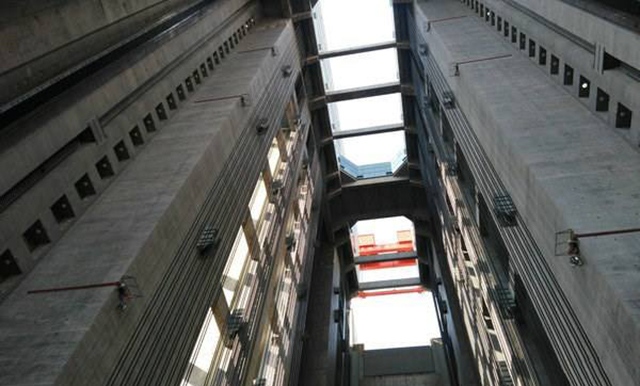
The Three Gorges Shiplift is a 3,000-ton ship that can be carried by the Shipyard of the Three Gorges Shiplift. The maximum climb tonnage is up to 1.55 million tons and the maximum climb height is 113 meters. The construction of the main works of the Three Gorges Shiplift and the installation of some equipment were completed by Gezhouba Group Three Gorges Construction Engineering Co., Ltd. for six and a half years.
The total length of the Three Gorges shiplift is about 5,000 meters. The height of the tower column is 146 meters. The maximum lifting height is 113 meters and the maximum lifting weight is more than 1.55 million tons. The length of the ship is 132 meters long, 23.4 meters wide and 10 meters high. It can lift ships of 3,000 tons to cross the dam. These data show that the Three Gorges ship lift is the world’s largest and most technically challenging ship lift project.
6.Beipanjiang Bridge(北盘江大桥)
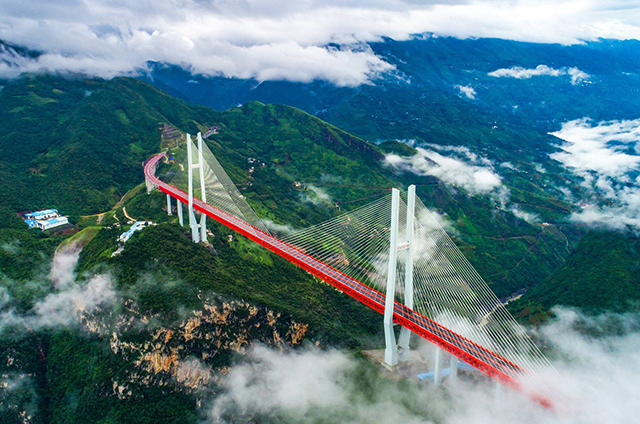
Gebei Panjiang Bridge: It spans Duge Town, Shuicheng County, Liupanshui City, Guizhou Province, and Pu Li Township, Xuanwei City, Yunnan Province. It is one of the three bridges of the Hengrui Expressway in Bijie to Duge Town (Qianjie). The bridge spans the Beipanjiang Grand Canyon at the junction of Yunnan and Guizhou provinces, and connects with the Xuanwei section of the Puli Township of Hangrui Expressway under construction in Yunnan Province.
The bridge was jointly built by Yunnan and Guizhou provinces with a total investment of 1.028 billion yuan, of which 537 million yuan was invested in Yunnan and 491 million yuan was invested in Guizhou. The total length of the bridge is 1341.4 meters, and the vertical height of the bridge to the bottom of the valley is 565 meters, which is equivalent to 200 stories. This is the highest cross-river bridge in the world: it is higher than the highest bridge in the world, Papua New Guinea’s Haijijiao Gorge Bridge (pipeline bridge). 100 metres.
Reasons for the high position: This is the karst landform area. The mountainous terrain is 10 km along the river. The limestone is densely covered and the hardness of the mountain is extremely poor. In order to avoid the caves and fissures scattered throughout the mountain, the designer constantly moves the bridge to a high position and finally the bridge deck. Set at this dazzling height.
On September 10, 2016, the vertical height of 565 meters, which was jointly established by Guizhou and Yunnan provinces, is equivalent to the 200-storey world’s first high-bridge Hangrui Expressway Beipanjiang Bridge—Hangrui Expressway, Guizhou Province, Bijie to Dudu The Beipanjiang Bridge of Ge (Bengjie) realized Helong. Opened on December 29th.
Change history: Duge Town of Guizhou Province and Pu Li Township of Yunnan Province look across the river. The residents of the two sides of the river have come to each other in history. It is necessary to climb over 3 hills and walk 40 kilometers of mountain roads to reach the opposite bank. The collection of Longjing Village in Duge Town from the opposite side of the hill The city has to walk for 3 hours. After the bridge is opened to traffic, the distance is near, and the journey from Xuanwei City in Yunnan Province to Liupanshui in Guizhou will be shortened from about 5 hours to more than one hour.
In May 2018, the Beipanjiang Bridge won the Gustavs Gold Award at the 35th International Bridge Conference. In September 2018, the Beipanjiang Bridge was certified by the Guinness World Records.
7.Qinghai-Tibet Railway(青藏铁路)

Qinghai-Tibet Railway, referred to as the Qinghai-Tibet Railway, is a national railway I-class railway connecting Xining City of Qinghai Province to Lhasa City of Tibet Autonomous Region. It is one of the four major projects in China’s new century and the first railway to the hinterland of Tibet. It is also the highest altitude railway in the world with the longest route.
The Qinghai-Tibet Railway was completed in two phases. The first phase of the project starts from Xining City in the east and Golmud City in the west. It started construction in 1958 and was completed and opened to traffic in May 1984. The second phase project, Golmud City in the east and Lhasa City in the west, June 2001 Construction started on the 29th, and the entire line was opened on July 1, 2006.
The Qinghai-Tibet Railway runs from Xining Station to Lhasa Station; the length of the line is 1,956 kilometers, including 814 kilometers from Xining to Golmud, and 1142 kilometers from Golmud to Lhasa. There are 85 stations in total, and the designed maximum speed is 160 kilometers/ Hours (Xining to Golmud), 100 km/h (Germu to Lhasa section). As of March 2015, the operation speed of the Qinghai-Tibet Railway was 140 km/h (Xining to Golmud) and 100 km/h (Germu to Lhasa).
8.Beijing Airport Logistics Base(北京空港物流基地)
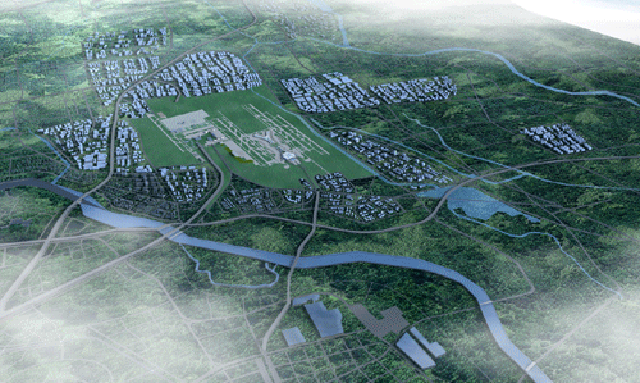
The base has been listed as a key project of the municipal government in successive years. It has been named as “China Logistics Experimental Base” and “China Logistics Demonstration Base” by the China Logistics Purchasing Federation. In 2007, it was rated as “National Logistics” by the Ministry of Personnel and the State The advanced collective of the industry has been rated as the highest grade 3A credit enterprise in the national logistics industry by the State Material Mining Association. In 2008, the base successfully completed the service guarantee work of the Olympic Logistics Center, and was jointly awarded the honorary title of “Advanced Collective of the Beijing Olympics Paralympic Games” by the Municipal Party Committee, the Municipal Government and the Beijing Olympic Organizing Committee. In 2009, it was identified by the China Logistics Association as “China Logistics Industry Research Base”.
Beijing Airport Logistics Base is located in the core area of Beijing’s high-end industrial functional area-Linkong Economic Zone. As the highest area where logistics enterprises gather, it is the best platform for enterprises to set up modern logistics centers and build corporate headquarters. The base has completed the construction of a municipal infrastructure with an “eight links and one leveling” within a range of 1.55 square kilometers. The company has introduced seven world top 500 companies including TNT, Nippon Yusen, and Sumitomo, as well as Sinotrans, Kintetsu, and Jumbo. Well-known logistics companies at home and abroad.
9.Three Gorges Hydroelectric Power Station(三峡水电站)
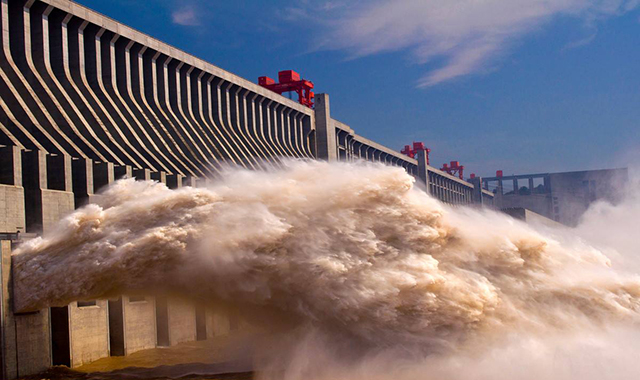
The Three Gorges Hydropower Station, the Yangtze River Three Gorges Water Conservancy Project, is also known as the Three Gorges Project. The Xiling Gorge section of the Yangtze River and the Gezhouba Hydropower Station in the lower reaches of Yichang City, Hubei Province, China constitute a cascade hydropower station.
The Three Gorges Hydropower Station is the largest hydropower station in the world and the largest construction project ever undertaken in China. The problems such as immigration relocation and environment caused by it have caused it to be accompanied by huge controversies from the moment of preparation. There are more than ten functions of the Three Gorges Hydropower Station, shipping, power generation, planting, etc. The Three Gorges Hydropower Station was approved by the National People’s Congress of China in 1992 and officially started construction in 1994. Water storage and power generation began on the afternoon of June 1, 2003, and was completed in 2009.
The unit equipment is mainly composed of VOITH, GE, SIEMENS, VGS consortium, ALSTOM, and ABB, Switzerland. provide. When they signed the supply agreement, they all promised to transfer the relevant technology to China’s domestic motor manufacturing enterprises without compensation. The power transmission and transformation system of the Three Gorges Hydropower Station is under construction and management by the State Grid Corporation of China. It is estimated that a total of 15 500 kV high-voltage transmission lines will be installed to connect to the regional power grids.
The dam of the Three Gorges Hydropower Station has an elevation of 185 meters, a water storage elevation of 175 meters, a reservoir length of 2,335 meters, a static investment of 135.266 billion yuan, and installation of 32 hydropower units with a single unit capacity of 700,000 kilowatts. The last hydropower unit of the Three Gorges Power Station was put into operation on July 4, 2012. This means that the Three Gorges Hydropower Station with an installed capacity of 22.4 million kilowatts has become the world’s largest hydropower station and clean energy production base on July 4, 2012. . At 8:25:21 on December 21, 2018, the Three Gorges Project produced a total of 100 billion kWh of green energy under the premise of giving full play to the huge comprehensive benefits of flood control, shipping and water resources utilization.
10.Hangzhou Bay Sea Cross Bridge(杭州湾跨海大桥)
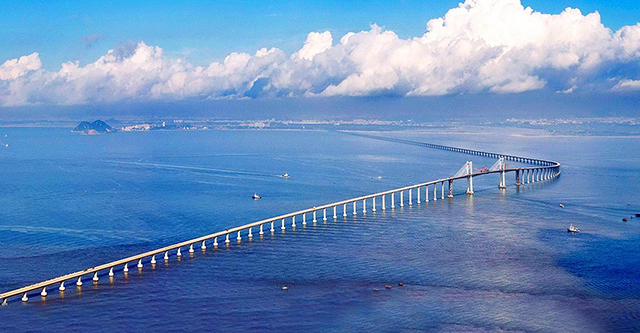
The Hangzhou Bay Sea Cross Bridge is a cross-sea bridge that spans the Hangzhou Bay of China. The bridge starts from Zhengjiatun, Haiyan, Jiaxing City, Zhejiang Province, and Cixi Waterway Bay, Ningbo, south, with a total length of 36 kilometers.
The Hangzhou Bay Bridge was opened to traffic on May 1, 2008. The bridge is designed according to the standard of two-way six-lane expressway and is an important part of the G15 Shenhai Expressway.
The Hangzhou Bay Bridge has maintained the world record for the World Record Association’s longest sea-crossing bridge in China. The Hangzhou Bay Bridge is the fourth longest sea-crossing bridge in the world after the Hong Kong-Zhuhai-Macao Bridge, the Pontchartrain Lake Bridge in the United States and the Jiaozhou Bay Bridge in Qingdao, China.